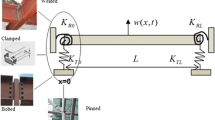Abstract
A non-ideal boundary condition is modeled as a linear combination of the ideal simply supported and the ideal clamped boundary conditions with the weighting factors k and 1-k, respectively. The proposed non-ideal boundary model is applied to the free vibration analyses of Euler-Bernoulli beam and Timoshenko beam. The free vibration analysis of the Euler-Bernoulli beam is carried out analytically, and the pseudospectral method is employed to accommodate the non-ideal boundary conditions in the analysis of the free vibration of Timoshenko beam. For the free vibration with the non-ideal boundary condition at one end and the free boundary condition at the other end, the natural frequencies of the beam decrease as k increases. The free vibration where both the ends of a beam are restrained by the non-ideal boundary conditions is also considered. It is found that when the non-ideal boundary conditions are close to the ideal clamped boundary conditions the natural frequencies are reduced noticeably as k increases. When the non-ideal boundary conditions are close to the ideal simply supported boundary conditions, however, the natural frequencies hardly change as k varies, which indicate that the proposed boundary condition model is more suitable to the non-ideal boundary condition close to the ideal clamped boundary condition.
Similar content being viewed by others
References
A. Cherki, G. Plessis, B. Lallemend, T. Tison and P. Level, Fuzzy behavior of mechanical systems with uncertain boundary conditions, Computer Methods in Applied Mechanics and Engineering, 189 (2000) 863–873.
M. Pakdemirli and H. Boyaci, Vibrations of a stretched beam with non-ideal boundary conditions, Mathematical & Computational Applications, 6(3) (2001) 217–220.
M. Pakdemirli and H. Boyaci, Effects of non-ideal boundary conditions on the vibrations of continuous systems, Journal of Sound and Vibration, 249(4) (2002) 815–823.
M. Pakdemirli and H. Boyaci, Non-linear vibrations of a simple-simple beam with a non-ideal support in between, Journal of Sound and Vibration, 268 (2003) 331–341.
M. Aydogdu and M. C. Ece, Buckling and vibration of nonideal simply supported rectangular isotropic plates, Mechanics Research Communications, 33 (2006) 532–540.
K. Malekzadeh, S. M. R. Khalili and P. Abbaspour, Vibration of non-ideal simpli supported laminated plate on an elastic foundation subject to in-plane stresses, Composite Structures, 92 (2010) 1478–1484.
U. Lee, 14.1 Identification of non-ideal boundary conditions, Spectral element method in structural dynamics, John Wiely & Sons, 2009.
F. Wang and S. Chen, A method to determine the boundary condition of the finite element model of a slender beam using measured modal parameters, ASME Journal of Vibration and Acoustics, 118 (1996) 474–478.
P. F. Pai, L. Huang, S. H. Gopalakrishnamurthy and J. H. Chung, Identification and application of boundary effects in beams, International Journal of Solids and Structures, 41 (2004) 3053–3080.
T. G. Ritto, R. Sampaio and E. Cataldo, Timoshenko beam with uncertainty on the boundary conditions, Journal of Brazilian Society of Mechanical Science and Engineering, 30 (2008) 295–303.
M. Sari and E. A. Butcher, Natural frequencies and critical loads of beams and columns with damaged boundaries using Chebyshev polynomials, International Journal of Engineering Science, 48 (2010) 862–873.
L. Wang and Z. Yang, Identification of boundary conditions of tapered beam-like structures using static flexibility measurements, Mechanical Systems and Signal Processing, 25 (2011) 2484–2500.
J. Lee, and W. W. Schultz, Eigenvalue analysis of Timoshenko beams and axisymmetric Mindlin plates by the pseudospectral method, Journal of Sound and Vibration, 269 (2004) 609–621.
Author information
Authors and Affiliations
Corresponding author
Additional information
Recommended by Editor Yeon June Kang
Jinhee Lee received B.S. and M.S. degrees from Seoul National University and KAIST in 1982 and 1984, respectively. He received his Ph.D degree from University of Michigan, Ann Arbor in 1992 and joined Dept. of Mechanical and Design Engineering of Hongik University in Sejong, Korea. His research interests include inverse problems, pseudospectral method, vibration and dynamic systems.
Rights and permissions
About this article
Cite this article
Lee, J. Free vibration analysis of beams with non-ideal clamped boundary conditions. J Mech Sci Technol 27, 297–303 (2013). https://doi.org/10.1007/s12206-012-1245-2
Received:
Revised:
Accepted:
Published:
Issue Date:
DOI: https://doi.org/10.1007/s12206-012-1245-2




